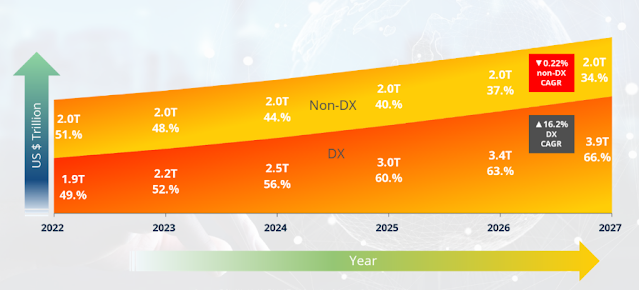As a C-suite leader, you’re constantly bombarded with investment opportunities. In today’s large enterprise arena, few initiatives hold the same potential as Digital Transformation (DX).
Yet, securing ongoing buy-in from the board and other key stakeholders hinges on a clear understanding of market momentum and the return on investment that DX promises.
A recent IDC worldwide market study sheds valuable light on this critical topic. Let’s delve into some key takeaways and explore what they mean for your organization’s tech strategy.
Digital Transformation Market Development
The IDC study describes a market surging toward investment adoption maturity. Worldwide spending on DX technologies is forecast to reach $4 trillion by 2027, reflecting a compound annual growth rate (CAGR) of 16.2 percent.
This exponential growth signifies an opportunity for industry leaders to leverage digital business tools and strategies to gain a competitive edge, with Artificial Intelligence (AI) and Generative AI (GenAI) driving new investments.
“Digital transformation is no longer a discretionary investment: companies that want to be competitive and win in the digital economy are leading the way,” said Angela Vacca, senior research manager at IDC.
The financial services industry is advancing with a five-year CAGR of 20.5 percent and three use cases that are growing. Robotic Process Automation-Based Claims Processing is the fastest-growing use case with a CAGR of 35.1 percent, followed by Real-time Financial Advice (29.5 percent) and Digital Banking Experience (29.3 percent).
These use cases have something in common: all three are highly data intensive and rely heavily on AI, Generative AI, and Data Analytics technologies. Financial institutions are becoming more customer-centric organizations that respond rapidly to changing demands.
Meanwhile, the industry that will see the largest DX investments over the 2022-2027 forecast period is Discrete Manufacturing with worldwide spending of almost half a trillion dollars in 2024.
This spending will grow to more than $700 billion in 2027 with Omni-Experience Engagement and Sustainability being the strategic priorities growing at the fastest pace among discrete manufacturing companies.
Geographically, the fastest-growing regions across the globe are Latin America and China, which will have five-year CAGRs of 17.9 percent and 17.4 percent, respectively.
The spending volume forecast is an indicator of confidence in DX technologies. However, it’s crucial to see beyond the numbers and understand the dynamics shaping this growth. Here are some key trends to consider:
- The Cloud Imperative: Cloud computing has become the foundation for most DX initiatives. Its scalability, flexibility, and cost-effectiveness make it an ideal platform for deploying and managing digital business solutions.
- The Rise of Artificial Intelligence: AI is rapidly transforming various aspects of business, from automating tasks to generating data-driven insights. Businesses that embrace AI will be well-positioned to optimize operations and create new value.
- The Evolving Security Landscape: As businesses become increasingly reliant on digital technologies, the need for robust cybersecurity measures becomes paramount.
While the market momentum for DX is undeniable, C-suite leaders must remain cognizant of the potential challenges that may lie ahead. Here are some key issues to consider:
- Project Justification: Clearly articulating the ROI of DX initiatives is critical to securing buy-in. Quantifiable outcome metrics that demonstrate the impact on key performance indicators are essential.
- Change Management: Successful DX requires a cultural shift within the organization. Leaders must champion innovation and provide employees with the training and support they need to adapt to new technologies and processes.
- Integration and Interoperability: A successful DX strategy should ensure integration between existing legacy IT systems and newly adopted technologies.
Outlook for Digital Business Applications Growth
Despite these challenges, the opportunities presented by DX initiatives are vast. By embracing digital business models, C-suite leaders can unlock accelerated levels of efficiency, create exceptional customer experiences, and propel their organizations toward sustainable growth.
That said, I believe senior executives seek a strategy compass to navigate this journey. By understanding the market momentum, key trends, and potential challenges, C-suite leaders can make informed decisions and position their organizations to thrive in the years ahead.
Remember, successful DX is not a one-time event; it’s a continuous change management process that requires ongoing commitment and progressive adaptation. Embrace the shift to digital business model innovation, and watch your organization reach its full growth potential.
